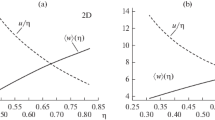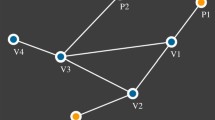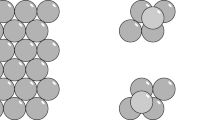Abstract
For packings of similar hard spheres, there are several characteristic values of density. First, this is the maximal possible degree of space filling by spheres η = 0.74, realized for the crystalline packing of spheres. Another known value, η = 0.64, is the limiting (critical) value for disordered packings. We also indicate two more characteristic values of density: η = 0.60 and η = 0.66, in the vicinity of which qualitative changes in structure can occur. Computer models of the packings of hard spheres are investigated in the range of densities 0.52 < η < 0.72. Each packing consisted of 10,000 spheres in a cube with periodic boundary conditions. The structural characteristics were investigated using Delaunay simplices, defining the arrangement of the nearest four atoms. Simplices that are close to a regular tetrahedron or quartoctahedron (quarter of an octahedron) are considered. These forms are typical for the densest crystal structures. Variation of the fraction and ratio of these simplices is studied as a function of the packing density. According to the results, the threshold value, η = 0.60, corresponds to the density after which correlation of the disordered arrangement of spheres increases considerably. When η = 0.64, the structural organization changes more radically; high density demands the emergence of local crystal nuclei. The density η = 0.66 is the limiting density at which the crystalline nuclei can exist as independently distributed regions. Closer packings can only occur if a global crystal structure arises in them.
Similar content being viewed by others
References
W. G. Hoover and F. H. Ree, J. Chem. Phys., 49, 3609–3612 (1968).
H. Reiss and A. D. Hammerich, J. Phys. Chem., 90, No. 23, 6252–6260 (1986).
P. Richard, L. Oger, J. P. Troadec, and J. P. Gervois, Phys. Rev. E, 60, No. 4, 4551–4560 (1999).
S. Auer and D. Frenkel, J. Chem. Phys., 120, 3015–3029 (2004).
T. C. Hales, Discrete Comput. Geom., 17, 1–51 (1997).
T. C. Hales, Ann. Mathem., 162, 1065–1185 (2005).
J. D. Bernal, Proc. R. Soc. London A, 280, 299–322 (1964).
T. Aste, M. Saadatfar, and T. J. Senden, Phys. Rev. E, 71, 061302 (2005).
W. S. Jodrey and E. M. Tory, Phys. Rev. A, 32, 2347–2351 (1985).
A. S. Clarke and H. Jonsson, Phys. Rev. E, 47, No. 6, 3975–3984 (1993).
M. D. Rintoul and S. Torquato, ibid., 58, No. 1, 532–537 (1998).
J. G. Berryman, Phys. Rev. A, 27, No. 2, 1053–1061 (1983).
G. Parisi and F. Zamponi, J. Chem. Phys., 123, 144501 (2005).
P. Jalali and M. Li, ibid., 120, No. 2, 1138/1139 (2004).
A. V. Anikeenko, N. N. Medvedev, A. Elsner, et al., Proceedings of the 3rd International Symposium on Voronoi Diagrams in Science and Engineering, B. Werner, IEEE Computer Society (2006), pp. 153–158.
R. Jullien, A. Pavlovitch, and P. Meakin, J. Phys. A: Math. Gen., 25, 4103–4113 (1992).
T. Aste, J. Phys.: Condens. Mat., 17, S2361-S2390 (2005).
M. Fanfoni and M. Tomellini, Nuovo Cimento, 20D, Nos. 7/8, 1171–1182 (1998).
S. Torquato, T. M. Truskett, and P. G. Debenedetti, Phys. Rev. Lett., 84, No. 10, 2064–2067 (2000).
Z. H. Stachurski, ibid., 90, No. 15, 155502-1-4 (2003).
K. Lochmann, A. V. Anikeenko, A. Elsner, et al., Eur. Phys. J. B, 53, 67–76 (2006).
W. S. Jodrey and E. M. Tory, Phys. Rev. A, 32, No. 4, 2347–2351 (1985).
A. Bezrukov, M. Bargiel, and D. Stoyan, Part. Part. Syst. Charact., 19, No. 2, 111–118 (2002).
M. Skoge, A. Donev, F. H. Stillinger, and S. Torquato, Phys. Rev. E, 74, 041127 (2006).
A. Okabe, B. Boots, K. Sugihara, and S. Chiu, Spatial Tessellations — Concepts and Applications of Voronoi Diagrams, Wiley, Chichester (2000).
N. N. Medvedev, Voronoi-Delaunay Method in Structural Studies of Noncrystalline Systems [in Russian], Siberian Division, Russian Academy of Sciences, Novosibirsk (2000).
N. N. Medvedev and Yu. I. Naberukhin, J. Non-Cryst. Solids, 94, 402–406 (1987).
A. V. Anikeenko, M. L. Gavrilova, and N. N. Medvedev, Jpn. J. Industr. Appl. Math., 22, 151–165 (2005).
Yu. I. Naberukhin, V. P. Voloshin, and N. N. Medvedev, Mol. Phys., 73, No. 4, 917–936 (1991).
A. V. Anikeenko and N. N. Medvedev, J. Struct. Chem., 47, No. 2, 267–276 (2006).
F. Spaepen, Nature, 408, 781/782 (2000).
Author information
Authors and Affiliations
Corresponding author
Additional information
__________
Translated from Zhurnal Strukturnoi Khimii, Vol. 48, No. 4, pp. 823–830, July–August, 2007.
Original Russian Text Copyright © 2007 by A. V. Anikeenko and N. N. Medvedev
Rights and permissions
About this article
Cite this article
Anikeenko, A.V., Medvedev, N.N. Structural characteristics of close packings of hard spheres. Critical densities. J Struct Chem 48, 774–781 (2007). https://doi.org/10.1007/s10947-007-0118-5
Received:
Issue Date:
DOI: https://doi.org/10.1007/s10947-007-0118-5




